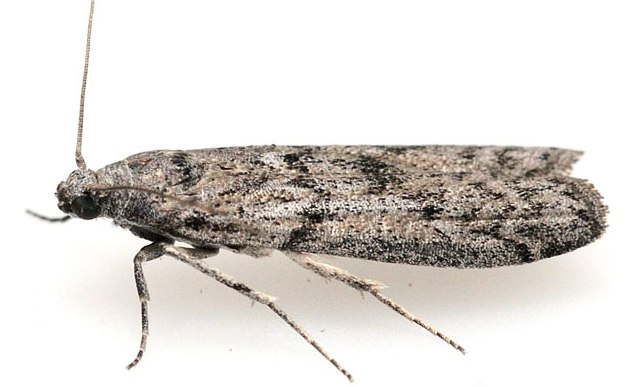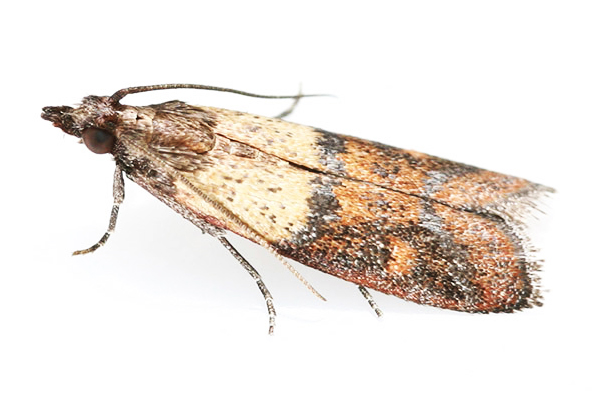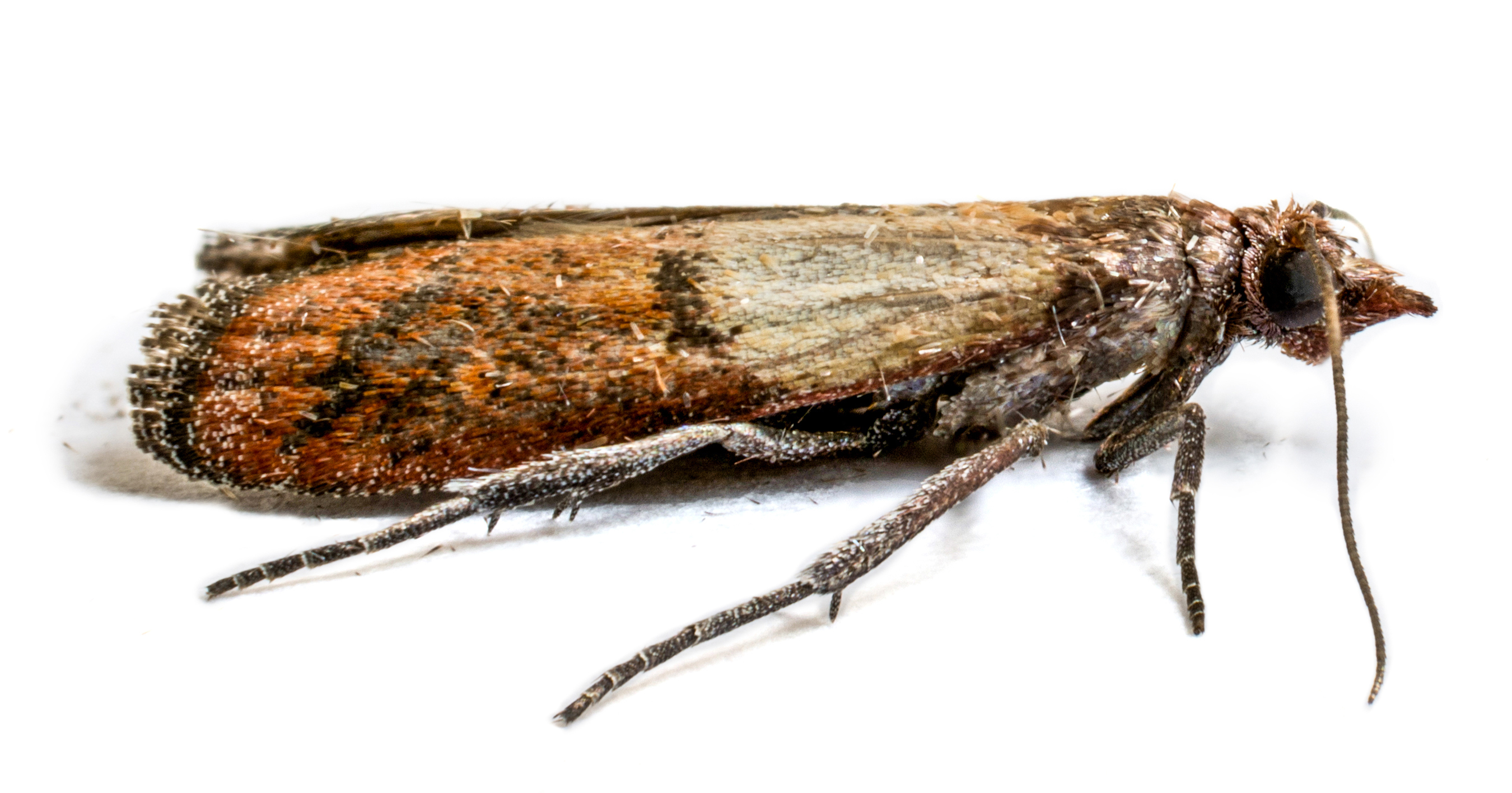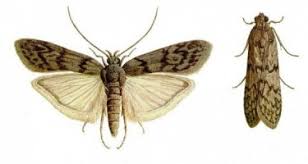
J & L Pest Control is a family owed business that has been practicing Integrated Pest Management (IPM) services since it was founded.
T (631)-605-9919
Email: jandlpestcontrol@gmail.com
J & L Pest Control
1090 Martinstien Ave.
Bay Shore, NY 11706

INTRODUCTION. Although now of worldwide distribution, this pest owes its common name to the belief that it originated in the Mediterranean region; others believe a Central American origin. It was first found in the United States in 1892, in California.
RECOGNITION. Adults with wingspread (wing tip to wing tip) about 1" (24 mm) or less. Front wings pale gray, each with 2 black zigzag transverse lines. Hind wings dirty white. With distinctive resting posture in which front of body is raised giving wings a distinct downward slope with tip of abdomen protruding up between them.
Mature larva about 5/8-3/41' (15-20 mm) long. Color pinkish white, head and prothoracic plate/shield dark reddish brown, and with some darker areas about base of some setae (hairs) but no rows of spots on dorsum or backside. With 5 pairs of well- developed prolegs on abdomen, each bearing crochets (hooks). Perspiracular tubercle (wartlike area between spiracle and front edge of segment) of prothorax with 2 setae (hairs). Tubercle VI on mesothorax (wartlike area near and above leg) with 1 seta (hair). On most of body, pinacula (dark or pale wartlike areas at base of hairs of setae) present. With large dark thickened ring about base of seta III (directly above spiracle) of mesothorax and abdominal segment 8. Spiracle of 8th abdominal segment about diameter of pale area enclosed by dark thickened ring about base of seta III.
SIMILAR GROUPS. (1) Almond moth (Cadra cautella) with 2 transverse bands on gray front wing, inner band dark, nearly straight and broadly bordered with paler band to its inside, outer band pale and wavy. (2) Tobacco moth (Ephestia elutella) with 2 transverse bands on gray front wing, inner band pale and bordered to outside with black, outer band pale and bordered on both sides with dark lines. (3) Meal moth (Pyralis farinalis) and clover hayworm (Hypsopygia costalis) with in addition to transverse bands on front wings y , also with 2 transverse bands on hind wings, both wings dark. (4) Other small moths with hind wing pale and larger than front wing, and/or lack gray front wing with black wavy transverse bands.
BIOLOGY. The female lays 116-678 white eggs in or on the food material, which hatch in 3-5 days. The larvae confine themselves in silken tubes and are full grown in about 40 days. They typically pupate in a silken cocoon but this may be lacking if pupation takes place in a crack or crevice. Regardless, pupation occurs in clean food material, away from the mass of infested material. The pupal stage lasts for 8-12 days. The life cycle (egg to egg) usually takes 8-10 weeks but in heated structures may be completed in 4-6 weeks. This means there may be 4-6 or more generations per year, depending on the tem¬perature.
HABITS. The adults cause no damage. The larvae cause most of the problems because as they crawl around extensively, and spin silken threads which mat food particles together. These silken food mats clog flour mill machinery, sometimes causing shutdown until they are removed. In homes, this extensive crawling about means the larvae can be found anywhere.
Adults are attracted to light.
The Mediterranean flour moth infests flour, cereals, bran, beans, biscuits, dry dog food, nuts, seeds, chocolate, dried fruits, and many other stored foods.
CONTROL. Follow the standard procedures for stored product pests.

INTRODUCTION. The Indianmeal moth was given its common name by an early American entomologist (Asa Fitch) who found it feeding on cornmeal (Indian meal). It is probably the most important and most commonly encountered pest of stored products found in the home and in grocery stores in the United States. Of Old World origin, it is now found worldwide.
RECOGNITION. Adults with wingspread (wing tip to wing tip) about 5/8-3Z4" (16-20 mm). Wings pale gray but front wing with outer 2/3's reddish brown with a coppery luster.
Mature larva usually about 1/2“ (range 9-19 mm) long. Usually dirty white but color may vary to a greenish or pinkish or brownish hue depending on its food, with head and prothoracic plate/shield yellowish brown to reddish brown. With 5 pairs of well-developed prolegs on abdomen and each bearing crochets (hooks). Prespiracular tubercle (wartlike area between spiracle and front edge of segment) of prothorax with 2 setae (hairs). Tubercle VI on mesothorax (wartlike area near and above leg) with 1 seta (hair). Body without pinacula (dark or pale wartlike area at base of hairs or setae) on mesothorax, metathorax, and 1st 9 abdominal segments. Rim around spiracles of about even thickness.
SIMILAR GROUPS. (1) Carpet/tapestry moth (Trichophaga tapetzella) with basal 1/3 of front wing dark brown to black, remainder of wing white mottled with gray and black. (2) Other small moths lack front wing with basal 1/3 pale and remainder dark, wing span of about 5/8-3/4" (16-19 mm), and/or hind wing broader than front wing and fringed with long hairlike scales.
BIOLOGY. Chiefly at night, the female lays 100-400 eggs, singly or in small groups, on the larval food material during a period of 1-18 days. Upon hatching, the larva establishes itself in a crevice of the food material. It feeds in or near a tunnellike case it has webbed together of frass and silk. The larval period lasts 13-288 days, depending primarily on temperature and food availability. When the last instar larva is ready to pupate, it leaves the food and wanders about until a suitable pupation site is found. There are usually 4-6 generations per year (range 4-8), with the life cycle (egg to egg) typically requiring 25-135 days (range 25-305).
HABITS. The adults cause no damage. The larvae are surface feeders and generally produce a lot of webbing throughout the infested part of materials. They are general feeders and attack grain and grain products, a wide variety of dried fruits, seeds, nuts, gra¬ham crackers, powdered milk, biscuits, chocolate, candies, dried red peppers, dry dog food, and bird seed. They are very destructive wherever dried fruits are stored. Preferred are the coarser grades of flour such as whole wheat, graham flour, and cornmeal, but they can breed in shelled or ear corn.
When the larvae wander about looking for pupation sites in homes, they are often mistaken for clothes moth larvae. Likewise, when the moths are flying, they are also mistaken for clothes moths.
Adults are attracted to light.
CONTROL. Follow the standard control procedures for stored product pests but remember that pupation takes place away from the infested food material.

INTRODUCTION. The Angoumois grain moth is so named because it was first reported destroying grain in this French province. It is of worldwide distribution and was introduced into North Carolina in 1728 from Europe. In the United States, it is considered second only to granary and rice weevils as a pest of stored grain.
RECOGNITION. Adults with wingspread (wing tip to wing tip) about 1/2-5/8" (12-17 mm). Color buff to pale yellowish brown. Hind wings abruptly narrowed at tip towards front wing and fringed/margined with hairlike scales, about as long as wing is wide.
Mature larva up to about 1/4" (7 mm) long. Color white with yellowish head and dark red¬dish-brown mouthparts. With 5 pairs of rudimentary (poorly developed) prolegs on abdomen, each with only 2 or 3 crochets (hooks). Body with primary setae (hairs) only, lacking tufted or secondary hairs. Perspiracular tubercle (wartlike area between spiracle and front edge of segment) on prothorax with 3 setae (hairs).
SIMILAR GROUPS. (1) Webbing clothes moth (Tineola bisselliella) has head with reddish tuft on top, hind wing not abruptly narrowed towards front margin at tip. (2) Casemaking clothes moth (Tinea pellionella) has front wing with 3 small dark spots, hind wing not abruptly narrowed towards front margin at tip. (3) Other small pale moths lack hind wing abruptly narrowed towards front margin, both front and hind wings long and narrow, and/or front wings of 1 color, not conspicuously patterned.
BIOLOGY. The female lays an average of 40 (range to 389) white eggs on or near grain. These turn red with age and hatch in 4-8 days. The 1st instar larva bores into a whole kernel and passes through a total of 3 instars in about 3 weeks, but may hibernate before pupation. It pupates within the hollowed-out kernel, and the pupal period lasts about IQ- 14 days. In warm climates the life cycle (egg to egg) usually requires 5-7 weeks, but may take 6 months in cool climates. In general, there are 2-5 generations per year but in heated buildings there may be as many as 10-12.
HABITS. Adults cause no damage. The larva requires a whole kernel or caked material for development. This pest is active at low temperatures and can cause considerable dam¬age during the winter. Infested grain has a sickening smell and taste which makes it unpalatable. The moths leave a lot of debris on top of infested grain.
Adults are attracted to light.
In the north, it overwinters as a larva and completes its development in early spring. The emerging moths fly out to the field in spring and lay eggs on the developing grain.
The Angoumois grain moth prefers to attack barley, rye, corn, oats, rice, and various seeds. It attacks both grains in the field and grains in storage, but only whole kernels. It prefers damp grain as opposed to old dry grain.
CONTROL. Follow the standard control practices for stored product pests.

INTRODUCTION. The common name results from its being a serious pest on almonds. It is also known as the dried currant moth and tropical warehouse moth, and was formally named Ephestia cautella (Walker). It is distributed throughout the warmer parts of the world, including the southern United States and California and in heated warehouses further north.
RECOGNITION. Adults with wingspread (wing tip to wing tip) about 9/16-7/8" (14-22 mm). Color mottled gray with 2 wavy transverse bands on front wing, inner band about midlength and blackish with paler area to its inside, outer band pale, often with some black on each side; hind wing pale gray. Hind wing not narrowed, with a short hair fringe less than half width of wing. Head with mouthparts/tongue well developed as a coiled tube. Hind wing with M2+3 and Cu, branching closer to discal cell than to wing
margin, Cu apparently 3-branched. Male genitalia with valve lacking terminal process; vaive with a prominent lateral (on side) thumblike costal process near midpoint, process less than half valve width. Female ovipositor short; bursa (sac) with 2-4 (rarely 1 or 5) sclerotized/darkened teeth (signa/lamina dentata), duct of bursa(between sac and ovipositor) with longitudinal sclerotized/darkened bar. Mature lava 1/2-5/8" (12-15 mm) long; with many primary hairs (setae), no tufts. Color dirty white to pale gray with head brown and many small dark spots including 4 rows of brown spots down back (middle 2 rows more dense); abdominal segments 1-8 with small pigmented raised areas (pinaculae) around hair/setal bases. Head smooth, with 6 ocelli on each side. With 5 pairs of well-developed prolegs on abdomen, each bearing many cro¬chets (hooks) in a circle. Prespiracular tubercle (wartlike area between spiracle and front edge of segment) of prothorax with 2 hairs (setae). Tubercle VI on mesothorax (wartlike area near and above leg) with 1 hair (seta). With large dark thickened round ring around base of seta III (directly above spiracle) of mesthorax and abdominal segment 8. Abdominal segments 1-8 with 2 hairs (setae) directly below spiracle within same tubercle/wartlike area. Abdominal segments 1-8 with top 2 hairs (setae) on most segments at same level, with rearward of 2 hairs (setae) 2-2.5 times length of headward hair (seta). Abdominal segment 8 with short hair (seta) in front of spiracle separated from spiracle by a distance equal to horizontal diameter of spiracle.
SIMILAR GROUPS. (1) Carob moth (Cadra calidella) has male genitalia valve with a prominent lateral thumblike process beyond midpoint towards valve end and female genitalia has bursa (sac) usually with 5 or more sclerotized/darkened teeth. (2) Raisin moth (Cadra figulilella) has male genital valve with long thumblike process, process more than half width of valve, and female genitalia has bursa duct (between sac and ovipositor) with spiral rings of sclerotized/darkened material. (3) Dried fruit (Vitula edmandsae serratilineella) and tobacco (Ephestia elutella) moths have front wings with several wavy dark transverse lines, male genital valve lacking thumblike process, and female ovipositor broadly rounded or obtuse. (4) Mediterranean flour moth (Anagasta kuehniella) has front wing with 2 black zigzag transverse bands/lines and discal spot (between bands), male genital valve with only a terminal process, and female ovipositor much elongated.
BIOLOGY. Adult females lay their eggs on/in the food material, averaging 114 eggs (range up to 300) in her lifetime. At 86°F/30°C, eggs hatch in 3 days. There are 5 larval instars which require 22 days at 90°F/32°C. Pupation takes about 7 days.
Developmental time (egg to adult) can be completed in 30-32 days under optimal conditions of 90°F/32°C and 70% RH, but can take place at temperatures between 60- 97°F/15-36°C. When reared in raisins, average times were: incubation 8 days, larval period 63.6 days, and pupal period 10.4 days, for an average development time of 81.7 days. Adults live for 1-2 weeks.
HABITS. The adults cause no damage. The larva usually lives inside a dense silken gallery amongst the food material and this tube gets filled with frass. In cooler regions, mature larvae overwinter in silken cocoons. With heavy infestations, the larvae usually leave the food material to pupate on the walls of the storage area. Adult emergence reaches its peak around dusk. Worldwide, dried fruits are the preferred food, especially figs and dates. However it does infest a wide range of stored vegetable materials such as flours, grains, cereals, cocoa beans, peanuts, and shelled nuts including almonds.
CONTROL. Please call us today for a free quote for elimination of these moths.
